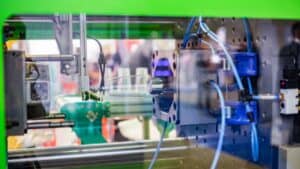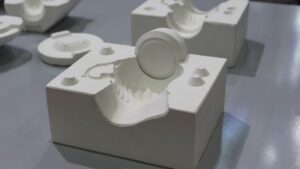Across industries, from medical devices and electronics to toys and sports equipment, printing patterns and decals on uneven surface has always been a common challenge. Pad printing is a printing process that allows manufacturers to fulfill such demands that other printing methods cannot easily handle. Understanding how pad printing works, what equipment it uses, and where it performs best can help you make better decisions when choosing a printing service for your manufactured parts and equipment.
Understand the Basics of Pad Printing Machines

Pad printing, also known as tampography or tampo printing, is an indirect offset printing process designed for transferring two-dimensional images onto three-dimensional objects. This method is ideal for applying detailed graphics to complex surfaces made of plastic, metal, glass, or rubber that are otherwise challenging to print on. The core of the process lies in the three essential components of a pad printing machine:
- A printing plate (or cliché), which is etched with the desired image.
- Specialized inks that dry through solvent evaporation, which increases their surface tackiness for smooth pickup by the pad.
- A flexible silicone pad that acts as the image carrier.
The special feature that enables it to perform printing on complex surfaces is “indirect transfer,” which refers to the image’s path: it never goes directly from the plate to the product. Instead, the silicone pad acts as an intermediate carrier. This allows the pad to conform to uneven, curved, or recessed surfaces without distorting the image.
Key Advantages of Pad Printing
Pad printing offers several technical and practical benefits that make it valuable for manufacturing and product decoration. It can print fine details, gradients, and small text on irregular or textured surfaces where screen or digital printing would fail.
Advantages include:
- Capable of printing on curved, concave, or textured parts
- Works with many materials, including plastics, metals, and ceramics
- Prints images with remarkable durability and high resolution
- Supports fast print cycles for large or small runs
How Pad Printing Works: Step-by-Step Process

Image Etching and Print Plate Preparation
The process begins with creating the cliché or printing plate. This piece of printing equipment carries the image to be printed as recessed areas etched into its surface. Pad printing plates are usually made from steel, ceramic, or polymer, depending on production volume and durability needs.
Etching can be done by laser engraving or chemical etching. The depth of the etched image determines how much ink it can hold. Deeper etches carry more ink but may reduce fine detail, while shallower etches improve precision.
| Plate Material | Durability | Typical Use |
|---|---|---|
| Polymer | Short runs | Prototyping |
| Thin steel | Medium runs | General production |
| Hardened steel | Long runs | Industrial printing |
Ink Application and Doctoring
Pad printing ink is applied to the etched plate using either an open inkwell system or a sealed ink cup. The ink fills the recessed image areas while covering the plate surface. Excess ink is removed by a doctor blade in open inkwell systems or by the precision rim of the ink cup itself in closed cup systems.
Ink composition includes pigments, solvents, and hardeners. Solvents control viscosity and drying speed, while hardeners improve adhesion and abrasion resistance. Operators adjust these components based on the substrate and environmental conditions.
Printing Ink Transfer with Silicone Pad
A silicone pad, serving as a transfer pad, picks up the inked image from the plate to the product surface. The pad’s elasticity allows it to conform to curved, textured, or irregular shapes.
When pressed onto the plate, the pad compresses and deforms momentarily, collecting a thin layer of ink. As it lifts, surface tension holds the ink on the pad. The pad then presses onto the object, releasing the ink through controlled pressure and contact time. Softer pads adapt better to uneven surfaces, while harder pads suit flat or detailed prints.
Curing and Post-Processing
After transfer, the pad lifts away, and the printed part undergoes curing to fix the ink. The method depends on the ink type—air-drying, heat-curing, or UV-curing. Curing solidifies the ink film and strengthens adhesion to the substrate.
Pad printing inks often contain additives that enhance resistance to wear, chemicals, or sunlight. Proper curing ensures these properties develop fully.
In some cases, post-processing includes surface cleaning, inspection, or protective coating. These steps confirm that the final print meets quality standards and maintains long-term durability on plastics, metals, or glass surfaces.
Materials and Surface Compatibility
Plastics, Metals, and Ceramics
Plastics are the most common materials used in pad printing. ABS, polycarbonate, and PVC allow strong ink adhesion after proper cleaning or priming. These plastics are found in electronics, automotive parts, and consumer goods where prints must resist wear.
Metals such as aluminum, stainless steel, and brass offer durability and a smooth surface for detailed prints. They often require pre-treatment to improve adhesion since bare metal can repel ink.
Ceramics, including porcelain and stoneware, provide hard, glossy surfaces. Their non-porous nature makes adhesion difficult without specialized inks or surface treatments such as flame or plasma to increase surface energy. When prepared correctly, ceramics yield crisp and long-lasting designs.
| Material Type | Common Uses | Adhesion Challenge | Typical Solution |
|---|---|---|---|
| ABS Plastic | Device housings, knobs | Low surface energy | Flame or chemical treatment |
| Aluminum | Automotive parts | Smooth surface | Priming or anodizing |
| Porcelain | Decorative items | Glossy surface | Roughening or special ink |
Surface Treatments for Adhesion
Surface treatment improves how ink bonds to low-energy materials like plastics and glass. Flame treatment, corona discharge, and plasma treatment increase surface energy, allowing ink to spread evenly and adhere firmly.
Chemical primers can also enhance bonding by forming a thin layer that reacts with both the substrate and the ink. Each method must match the material type to avoid surface damage.
Pad Printing vs. Screen Printing

Pad printing and screen printing are two dominant methods for transferring ink onto surfaces, yet they are defined by fundamentally different approaches. The core feature that distinguishes the two is the adaptability to surface geometry: pad printing excels on complex, three-dimensional objects, while screen printing is the preferred choice for large, flat areas.
| Feature | Pad Printing | Screen Printing |
|---|---|---|
| Process | Uses a flexible silicone pad to pick up an image from an etched plate and transfer it onto the product. | Forces ink through a stenciled mesh screen directly onto the surface. |
| Ideal Surface | Curved, uneven, recessed, or textured 3D surfaces. | Flat or minimally curved surfaces. |
| Image Size & Detail | Small to medium areas with high precision and fine detail. | Medium to large areas with bold, solid graphics; moderate detail. |
| Output & Strengths | Durable, high-resolution prints on complex shapes. | Thick, opaque ink layers with vibrant color and high durability. |
Choosing the Right Printing Process
When choosing from the two, the method used should hinge on the project’s specific requirements:
- Choose Pad Printing for applying small, intricate designs onto complex, irregularly shaped parts. Its flexibility makes it indispensable in industries like medical devices, automotive, and consumer electronics, where precision placement on components like pens, syringes, or device housings is critical. It offers a compact and cost-effective solution for multi-surface applications.
- Choose Screen Printing for large, bold designs on flat or nearly flat substrates. It is unmatched for high-volume production on textiles (apparel), signage, posters, and packaging, where color density, durability, and coverage are the top priorities. A single setup can efficiently produce thousands of consistent prints.
Pad Printing Applications and Industry Uses
Medical and Automotive
In the medical field, pad printing marks tools, syringes, and surgical devices with measurement lines, serial numbers, and logos. It produces fine, sterile-resistant markings that remain intact through cleaning and sterilization. This precision helps ensure traceability and compliance with health regulations.
Common medical uses include:
- Graduations on syringes and vials
- Branding on surgical handles
- Safety and dosage indicators
For manufactured automotive parts, pad printing adds text, icons, and symbols to dashboards, buttons, and control knobs. It adheres well to textured and curved surfaces, maintaining legibility despite frequent contact and heat exposure. Manufacturers rely on it for safety labeling, component identification, and aesthetic detailing on both interior and exterior parts.
Consumer Electronics and Promotional Products
Pad printing enhances consumer electronics by applying crisp branding and functional symbols to devices such as smartphones, remote controls, and headphones. It works on plastic, metal, and coated parts where other printing methods may not adhere properly. The process ensures consistent, high-resolution markings even on small or irregular components.
In promotional products, pad printing customizes items like pens, mugs, and USB drives. Companies use it to apply logos, slogans, and decorative designs that resist wear from daily handling. Its ability to print multiple colors and fine details makes it a preferred method for marketing merchandise that demands both visual appeal and durability.
Special Effects and Other Applications
Pad printing also supports special effects such as metallic, matte, or textured finishes. It can apply coatings that improve grip or visibility, especially on tools and equipment.
In industrial and niche applications, it marks parts for traceability, compliance, and user guidance. Examples include serial numbers on machinery, calibration marks on instruments, and identification codes on small components.
For 3D-printed or injection-molded parts, pad printing provides an efficient way to add branding or instructions without altering the part’s shape or material properties. Its flexibility makes it valuable for low- and high-volume production alike.
Conclusion
In summary, pad printing technology stands as one of the optimal solutions for applying graphics to complex geometries. Its unique features empower engineers to integrate branding, instructions, and aesthetics directly onto the functional forms of their product, which has been proven to be a net plus for manufacturers’ service packages. As industries continue to evolve with production techniques and market demands, the versatility and precision of pad printing will remain indispensable for turning conceptual products into tangible, market-ready goods.






